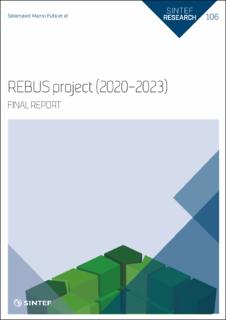| dc.description.abstract | REBUS project vision and objectives: The research project REBUS – REuse of Building materials – a USer perspective started in 2020 with a vision of developing a knowledge platform to enable the wider and more efficient implementation of reusable building materials. REBUS aimed to address the main barriers to reuse in the construction sector using research-based approach by identifying the need of different user groups (WP1), develop methods for assessing the technical performance (WP2) and sustainability of reuse products (WP3), and practical knowledge exchange from actual pilots (WP4) and use of network strategies (WP5).
Basic facts about REBUS: The REBUS project was an interdisciplinary collaboration between SINTEF, Inland Norway University of Applied Science, FutureBuilt, Resirqel, and Boligbygg Oslo KF from Norway, Department of the Built Environment at Aalborg university in Denmark (BUILD), and IVL Swedish Environmental Research Institute. The project was financed by the Research Council of Norway under the program Miljøforsk (grant number 302754), and in-kind contributions of industry partners, who provided their expertise and resources.
Main activities and results: The project started by screening the reuse potential of more than 50 construction product groups. This was done through input from experts from SINTEF as well as discussions in a series of workshops with REBUS partners (WP1). From this assess-ment, five construction products were chosen to be considered in REBUS: paving stone, doors and windows, glass partition wall, ventilation components, and sanitary equipment. To get more practical knowledge, the technical, environmental, and economic performance of reused paving stone was evaluated through laboratory testing, life cycle assessment (LCA) and life cycle costing (LCC) studies (WP2). A reuse guideline was then developed for the remaining four products (doors and windows, glass partition walls, ventilation components and sanitary equipment) giving advice to consultants, developers, and contractors on how to assess and document the properties of reusable building materials (WP2).
To understand the challenges, motivations, and potential measures for driving different user groups to reuse building materials in Norway, a national survey (WP1 & WP5) was conducted. In addition, semi-structured interviews (WP1 & WP4) were conducted with various actors in the building industry to identify practical challenges, barriers, and success factors related to the reuse of construction products in Norwegian pilot projects. To gather more practical know-ledge on the reuse of construction materials, a comparative assessment of exemplary pilot projects from Norway, Denmark, and Belgium was conducted (WP1 &WP4). Moreover, a review of approaches to reuse of building materials was conducted through evaluation of the current state of circularity in the Norwegian building industry, including actors, approaches, and developments (WP4).
To address the research gap on the lack of harmonized life cycle sustainability assessment (LCSA) methods, a LCSA framework was developed (WP3). The framework was developed harmonizing environmental life cycle assessment (LCA), social LCA and life cycle costing (LCC) assessment methods to enable transparently assess the potential environmental, social and/or cost impacts of reused products in comparison to new ones.
A network strategy was used to facilitate exchange of knowledge developed through REBUS as well as the experiences of partners and other key players within the network members (WP5). This exchange of ideas and insights served as a valuable input to providing recommendations on how procurement and political instruments can affect sustainable reuse of building products.
The findings from REBUS project were made accessible to a wider audience through various channels aimed to achieve the ambition of creating research-based knowledge (WP6). Specifically, the project results were published in three peer-reviewed journals, one book chapter, and three reports and communicated through popular scientific articles, presentations at different events, webinars, and seminars.
Expected impacts:
• The research-based knowledge on reuse of existing construction products from different user aspects through a national survey, interviews, and comparative assessment of exem-plary pilots from Norway, Denmark and Belgium can provide a better understanding of the status of reuse for different actors.
• The research on the technical performance of reused paving stone, through actual map-ping, laboratory testing, LCA and LCC analysis can provide guidance for further develop-ment of testing, documentation, environmental and economic analysis of reusable pro-ducts. Moreover, the reuse guidance document demonstrated how existing methods can be used to test and document reusable products, which can serve as a good example for developing routines for testing and documentation of reused products.
• The LCSA framework developed through REBUS can support transparent evaluation of the environmental, social, and/or economic impacts and benefits of reused products in comparison to new products.
• The review of material reuse approach and the practical knowledge collected from pilot projects can give better insight into historical developments as well as perspectives of professional actors involved in the limited pilot projects.
• The network established through REBUS helped to contribute towards influencing the participants’ attitudes and actions for reuse of building materials.
• Furthermore, the results from REBUS contribute to several of the UN sustainable develop-ment goals including: SDG12 (Responsible production and consumption), SDG13 (Climate action), SDG14 (Life below water), SDG15 (Life on land), SDG11 (Sustainable cities and communities), SDG8 (Decent work and economic growth), and SDG9 (Indust-ries, innovation, and infrastructure). | en_US |

